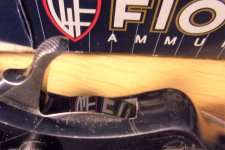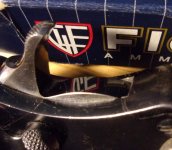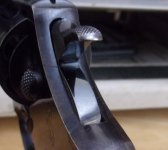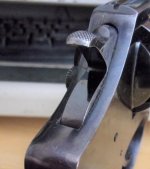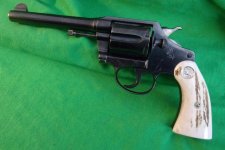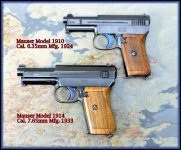I was cleaning up this 1924 mfg. Colt Police Positive .38 and was struck by the mirror blue on the back of the hammer. I had to take a few pics. to see if I could capture it. Wow - 96 year old blue. I know Colt did "Royal Blue" Pythons. Maybe those are as close as it gets.
You are using an out of date browser. It may not display this or other websites correctly.
You should upgrade or use an alternative browser.
You should upgrade or use an alternative browser.
I wish I had a whole gun blued like THIS !
- Thread starter bigmtnman
- Start date
It would be nice if blued guns came that way. I only have one that looks that good
The Python did not yet exist in 1924
The 357 Magnum cartridge only came on the scene in 1935
It is all in the prep work, superior polishing produced a superior blue.
The Python did not yet exist in 1924
The 357 Magnum cartridge only came on the scene in 1935
It is all in the prep work, superior polishing produced a superior blue.
ralph7
Member
Yeah, I have a 1910 Army Special that has that same look on the hammer.
Must be the metal because that radiance doesn't appear anywhere
else on the gun, does it?
Must be the metal because that radiance doesn't appear anywhere
else on the gun, does it?
Rammer Jammer
Member
I typically prefer stainless guns over blued. But I picked up a Lipsey's exclusive Ruger Bearcat that has a high polished blue. Looks great
ruger.com/products/newBearcat/specSheets/0921.html
ruger.com/products/newBearcat/specSheets/0921.html
ContinentalOp
Member
- Joined
- Apr 14, 2009
- Messages
- 6,315
- Reaction score
- 12,811
I'm normally a pragmatist, so I prefer matte or stainless finishes.
But there is something about a polished blue finish. I can't remember his name, but I know there's a member here with a 1911 with a crazy polished blue finish. Looks like that hammer but all over.
Maybe he'll see this and post a picture...? *fingers crossed*
But there is something about a polished blue finish. I can't remember his name, but I know there's a member here with a 1911 with a crazy polished blue finish. Looks like that hammer but all over.
Maybe he'll see this and post a picture...? *fingers crossed*
Inusuit
Member
I have a 1906 vintage Colt New Service in .45 Colt with that finish on the back of the hammer and the back of the trigger.
I think it's called fire blue or nitre blue.
"The process involves immersion of the part into a hot liquid potassium nitrate, which generates an evenly colored finish. Like all bluing processes, the most important step is metal preparation."
Apparently it is a fairly fragile finish, so used mostly on small parts. I think one of the importers of Italian SAA replicas may have offered the finish on complete firearms at one time, but I can't find that reference.
I think it's called fire blue or nitre blue.
"The process involves immersion of the part into a hot liquid potassium nitrate, which generates an evenly colored finish. Like all bluing processes, the most important step is metal preparation."
Apparently it is a fairly fragile finish, so used mostly on small parts. I think one of the importers of Italian SAA replicas may have offered the finish on complete firearms at one time, but I can't find that reference.
gregintenn
Member
Same finish as the screw heads on a Single Action Army. Nitre blue I think it’s called. I’m not sure why they couldn’t do an entire gun with it. It is beautiful.
Walter Rego
Member
I have a Colt Officers Model Target .38 from 1940. The sides and face of the trigger, the cylinder release, the top and rear face of the hammer and the screws are all niter blued like that. It is a beautiful touch and not often seen today.
There's still some left on my 1877 "Lightning"...made in the early 1900s...wish I had a better photo:

Best Regards, Les

Best Regards, Les
Protocall_Design
Vendor
Nitre blue is the deep iridescent blue that almost glows on it's own. It is usually only seen on collector guns now, since it doesn't hold up to wear very well. There is nothing more beautiful than a highly polished Nitre blue with a highly figured piece of wood, though.
inspcalahan
Member
It's coincidental that you just posted this! I was getting stuff out of the safe for a range session last night and moved a few Police Positives out of the way. In doing so, one caught my eye with the same amazing polished blueing that you showed! I thought "hey, I need to try and get pictures of this one day". Fully agreed, it's a finish to be amazed at.
Could you imagine what it would have been like to walk into a gun store in the 1920's and handle what was offered on the shelf??!!
Could you imagine what it would have been like to walk into a gun store in the 1920's and handle what was offered on the shelf??!!
You can do the entire gun that way.
Just need a container big enough to completely dunk the parts in molten NItre Salts. Nitre can be either Sodium Nitrate or you can use Potassium Nitrate. I've even used Ammonium Nitrate and had good results.
A dangerous operation to work with if you do consider this. Even a small set up is dangerous and you need to take all precautions when working with the stuff. It can seriously burn.
It's heat temper color, nothing else. But it's done while the part(s) are completely shut off from the atmosphere and any oxygen in it. That way the color change and look isn't effected by oxide forming on the surface.
It's most effective visually when high polish is employed and extreme skilled flat, no ripple, sharp edged work.
Like you see on the Colt parts.
The process is also and sometimes primarily, a draw back/tempering of the steel after hardening.
The color a simple nice after effect.
The bright blues just happens to appear at the correct tempering temps.
It's the same process as 'Straw' coloring on auto pistol parts like Luger, ect.
Flat springs and V springs are(were) often drawn back after hardening in Nitre or even molten lead at around 750F. That temp will give you a dark blue color to the metal, But more importantly it will temper the fragile hard spring to a degree that actually gives you a 'spring'.
The name 'spring temper blue' comes from that process and color.
I think that's what was done on the Colt DA hammers. They were hardened. Then drawn back in the molten salts which left them with the bright blue color. Then the sides repolished to 'In the White' for a contrast.
Run the temp of the NItre to around 850+F and the color of the polished steel will come out a darker blue black. This is often used to mimic Charcoal Blue or Carbona Blueing on restorations.
More easily done in a small shop than running a small gas furnace and hoping for the best while rotating the parts in a cylinder sealed up with bone char inside and a little oil.
The temps that it runs at 850+F are the same for the Nitre ,the open hearth charcoal blue process, and the CArbona Blue American GAs furnace process to get about the same result.
Cimmaron Arms (Uberti made?) used to offer some of their SAA with the blued parts done up in spring temper Nitre blue. Very pretty.
But very fragile finish.
Just need a container big enough to completely dunk the parts in molten NItre Salts. Nitre can be either Sodium Nitrate or you can use Potassium Nitrate. I've even used Ammonium Nitrate and had good results.
A dangerous operation to work with if you do consider this. Even a small set up is dangerous and you need to take all precautions when working with the stuff. It can seriously burn.
It's heat temper color, nothing else. But it's done while the part(s) are completely shut off from the atmosphere and any oxygen in it. That way the color change and look isn't effected by oxide forming on the surface.
It's most effective visually when high polish is employed and extreme skilled flat, no ripple, sharp edged work.
Like you see on the Colt parts.
The process is also and sometimes primarily, a draw back/tempering of the steel after hardening.
The color a simple nice after effect.
The bright blues just happens to appear at the correct tempering temps.
It's the same process as 'Straw' coloring on auto pistol parts like Luger, ect.
Flat springs and V springs are(were) often drawn back after hardening in Nitre or even molten lead at around 750F. That temp will give you a dark blue color to the metal, But more importantly it will temper the fragile hard spring to a degree that actually gives you a 'spring'.
The name 'spring temper blue' comes from that process and color.
I think that's what was done on the Colt DA hammers. They were hardened. Then drawn back in the molten salts which left them with the bright blue color. Then the sides repolished to 'In the White' for a contrast.
Run the temp of the NItre to around 850+F and the color of the polished steel will come out a darker blue black. This is often used to mimic Charcoal Blue or Carbona Blueing on restorations.
More easily done in a small shop than running a small gas furnace and hoping for the best while rotating the parts in a cylinder sealed up with bone char inside and a little oil.
The temps that it runs at 850+F are the same for the Nitre ,the open hearth charcoal blue process, and the CArbona Blue American GAs furnace process to get about the same result.
Cimmaron Arms (Uberti made?) used to offer some of their SAA with the blued parts done up in spring temper Nitre blue. Very pretty.
But very fragile finish.
hkcavalier
US Veteran
Colt did this on small parts, generally stopping around 1915 or so. Like almost everything gun related from this era, there isn't a hard date. Commercial 1911s had gorgeous nitre bluing on the small parts. You also find their wheelguns with similar treatment on the small parts as well.


Walter Rego
Member
nicky4968
Member
I’ve been lusting after this Turnbull beauty since I first saw it.
Colt 1903 Pocket Hammer - Turnbull Restoration
Colt 1903 Pocket Hammer - Turnbull Restoration
Similar threads
- Replies
- 19
- Views
- 4K
- Replies
- 2
- Views
- 396
- Replies
- 5
- Views
- 572
- Replies
- 15
- Views
- 1K
- Replies
- 28
- Views
- 2K

